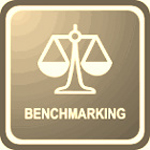
Why benchmark measurement is important?
- For investors, you need to understand the right benchmark for judging the quality of your investment and always seek better alternatives.
- For advisers, you need to identify the right benchmark to make the best proposal and select better choices for your clients.
The challenge of measuring the quality of an investment as compared to its corresponding benchmark has been more of an art than a science in the past. More relevant and achievable benchmarks will greatly benefit investors in selecting better investment alternatives.
For example, many actively managed funds and portfolios were supposed to achieve upside potential. In reality, the "bets" made by the managers and high fees (often hidden) made the performance even worse. The investment advisory industry in the past fails to create added value for investors, if any at all. Examples of Risk/Return performance charts for six real accounts are shown below. The "professionally" managed accounts (middle charts) are better than the self-directed accounts (left charts) but fails to perform as good as the industry benchmarks. Examples of the optimized portfolios created by ISIR are shown on the right.
For example, many actively managed funds and portfolios were supposed to achieve upside potential. In reality, the "bets" made by the managers and high fees (often hidden) made the performance even worse. The investment advisory industry in the past fails to create added value for investors, if any at all. Examples of Risk/Return performance charts for six real accounts are shown below. The "professionally" managed accounts (middle charts) are better than the self-directed accounts (left charts) but fails to perform as good as the industry benchmarks. Examples of the optimized portfolios created by ISIR are shown on the right.
Any investor must understand his/her portfolio should be performing as good or better than the corresponding benchmark for the defined risk level and time period. Otherwise, you are either paying unnecessary fees for under-performance or possibly fooled by the industry's flawed practice.
With the rapid growth and evolution of exchanged traded funds (ETF), we believe that more customized benchmarks should be developed based on investors' desired themes beyond popular market indexes such as the S&P 500. These theme-based benchmarks are actually optimized portfolios of ETFs to match the theme selected by investors and their advisers with the defined risk acceptance level and time period. The value of portfolio advisory can then be validated if there is no better theme-based ETF portfolio benchmark available, which can always be adopted as an alternative at a lower cost.
Selected Portfolios Based on Theme-Based Benchmarks
With the development of ISIR's new theme-based benchmarks (see below), investors can easily build a diversified portfolio by combining multiple theme-based benchmarks. Three actual common portfolios with the theme of US Income, US Growth, and Global Growth, respectively, have achieved better performance over their allocation benchmarks are shown as follows. The days of high-cost portfolio management with under-performance are over.
With the development of ISIR's new theme-based benchmarks (see below), investors can easily build a diversified portfolio by combining multiple theme-based benchmarks. Three actual common portfolios with the theme of US Income, US Growth, and Global Growth, respectively, have achieved better performance over their allocation benchmarks are shown as follows. The days of high-cost portfolio management with under-performance are over.
Selected New Theme-Based Benchmarks
- We welcome anyone to submit new theme-based benchmarks. The investment theme must be constructed by a real ETF portfolio with at least a 12-month performance history since inception.
- Included below are 13 additional theme-based benchmarks with over 12 months history developed by ISIR. Each of them is constructed by a real ETF portfolio. All of them have been match or out-performing the industry popular benchmarks since inception.
- Note that the theme "Systematic Global Growth" is purposely designed to only match the performance of its index based asset allocation benchmark (not out-performing). It shows the minimum portfolio performance that investors should expect from their advisors.
- ISIR is continuously developing and add new theme-based benchmarks such as SuperTech Growth. The performance charts will be updated as soon as sufficient data are made available.
- The complete up-to-date performance reports for all these portfolios are available upon request.
Remarks:
- The recent extensive research conducted by ERI Scientific Beta shows that the financial industry is evolving to introduce multi-factor indexes in contrast to the traditional single factor indexes such as the S&P 500 index. However, the characteristics of the current offering in the industry are lack of consistency in its methodologies offered to define factors, along with the mismatch between the academic research that justifies factor investing and the definition of these same factors by index providers. These problems are a source of lack of robustness for the offerings and this can be seen additionally in the poor live performance of the indexes proposed, whose design is ultimately guided more by a concern to display simulated performance than by practical robustness.
- The Theme-Based Benchmarks shown above by ISIR are designed with retail investors in mind, not for financial institutions as promoted by ERI Scientific Beta. ISIR's goal is to empower investors to effectively evaluate institutionally managed portfolios. The Theme-Based Benchmarks are fully backed up by real ETF portfolios, instead of simulated indexes many of which often demonstrated poor performance and/or weak robustness soon after becoming real-world products.
References





























